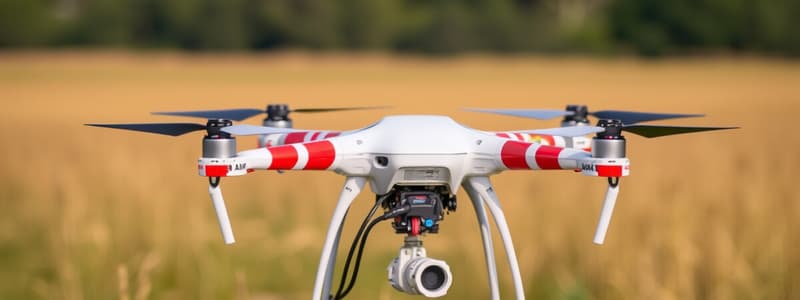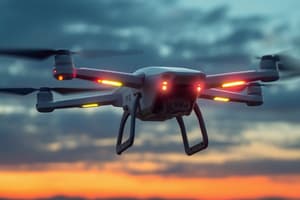Podcast
Questions and Answers
What is the minimum launch and recover runway length for the K1000P UAS?
What is the minimum launch and recover runway length for the K1000P UAS?
1300 ft (400 m)
Which waypoint type is only used for the initial takeoff?
Which waypoint type is only used for the initial takeoff?
- LOITER_TO_ALT
- TAKEOFF (correct)
- WAYPOINT
- DO_LAND_START
The takeoff angle for the K1000P should be exactly 5°.
The takeoff angle for the K1000P should be exactly 5°.
False (B)
What is the loiter altitude for LiDAR inspection for the K1000P?
What is the loiter altitude for LiDAR inspection for the K1000P?
The _______ marks the start of the landing sequence.
The _______ marks the start of the landing sequence.
What is the altitude setting when completing the TAKEOFF maneuver for the K1000P?
What is the altitude setting when completing the TAKEOFF maneuver for the K1000P?
What should the initial loiter altitude be set to for the K1000P?
What should the initial loiter altitude be set to for the K1000P?
The landing approach angle for the K1000P should be -2.5°.
The landing approach angle for the K1000P should be -2.5°.
Waypoints must be planned using ______ altitude for local takeoff and landing mission partials.
Waypoints must be planned using ______ altitude for local takeoff and landing mission partials.
What is the minimum launch and recovery runway length for the K1000P UAS?
What is the minimum launch and recovery runway length for the K1000P UAS?
What is the initial loiter altitude for the K1000P during takeoff?
What is the initial loiter altitude for the K1000P during takeoff?
What is the landing approach angle for the K1000P?
What is the landing approach angle for the K1000P?
Which waypoint is always the first during the takeoff of the K1000P?
Which waypoint is always the first during the takeoff of the K1000P?
The aircraft will maintain the observed GPS heading until the _____ requirement is satisfied.
The aircraft will maintain the observed GPS heading until the _____ requirement is satisfied.
How long will the K1000P loiter if the LOITER_TIME parameter is set to 600?
How long will the K1000P loiter if the LOITER_TIME parameter is set to 600?
The DO_LAND_START waypoint triggers the end of the landing sequence.
The DO_LAND_START waypoint triggers the end of the landing sequence.
Flashcards are hidden until you start studying
Study Notes
Mission Planning Overview
- The K1000P UAS requires specific mission planning for takeoff and landing using Ardupilot Mission Planner.
- Minimum runway length for takeoff and landing is 1300ft (400m).
- Each qualified flying field must have independent mission plans for both runway directions and combined operations.
Takeoff and Landing Procedures
- Takeoff angle: 4° ± 1°, initial loiter altitude: 400ft (120m), LiDAR inspection altitude: 200ft (60m), landing approach angle: -2.5°.
- Distances and altitudes in the reference pattern should be followed closely, while lateral distances and altitudes may be adjusted as needed.
Takeoff Details
- TAKEOFF waypoint is the first in the mission sequence, with altitude set to 5 meters relative to the runway.
- During the TAKEOFF maneuver, the aircraft maintains its GPS heading until the altitude requirement is met.
- The waypoint approach features:
- Waypoint at 115ft (35m) should support a 4° ascent angle.
- Waypoint completion is based on lateral proximity, not necessarily altitude.
Flight Path Sequence
- Crosswind leg establishes the flight pattern.
- Initial loiter position set through LOITER_TO_ALT, completed upon reaching the designated altitude.
- LOITER_TIME enables extended loitering for a specified duration (e.g., 10 minutes).
Landing Procedures
- DO_LAND_START waypoint triggers the landing sequence; typically autonomous with emergency protocols.
- Flexibility in waypoint execution, allowing for skipping certain points during GUIDED mode.
Mission Planning for K1000P Fixed Wing
- The K1000P UAS requires specific planning for takeoff, landing, linear, and grid missions using the Ardupilot Mission Planner.
- Minimum launch and recovery runway length is 1300 ft (400 m).
- Each flying field needs separate mission plans for takeoff and landing in both directions.
- Example plans for taxiway scenarios illustrate required configurations.
Takeoff and Landing Specifications
- Reference takeoff and landing patterns dictate critical parameters for operation.
- Takeoff needs a departure angle of 4° ± 1° and initial loiter altitude of 400 ft (120 m).
- LiDAR inspection altitude should be set to 200 ft (60 m).
- Landing approach angle must adhere strictly to -2.5° for optimal performance.
- Local takeoff and landing missions utilize relative altitude (AFE), while waypoint-based missions use absolute altitude (MSL).
Detailed Takeoff Procedures
- Takeoff Waypoint: First waypoint; altitude must reach 5 meters for successful takeoff.
- Waypoint (1): Positioned upwind at 115 ft (35 m) to achieve a 4° ascent.
- Waypoint (2): Establishes a crosswind leg for pattern formation.
- Loiter to Altitude: Indicates the initial loiter position; completion based on altitude criteria.
- Loiter Time: Defines the loiter duration (e.g., 600 seconds for 10 minutes) for post-takeoff tasks.
Landing Procedures
- Landing process involves specific waypoints, with emphasis on relative altitudes (AFE).
- DO_LAND_START: Marks the beginning of the autonomous landing sequence, improvisable in emergencies.
- Emergency protocols may allow bypassing certain waypoints during guided flight control.
Studying That Suits You
Use AI to generate personalized quizzes and flashcards to suit your learning preferences.




